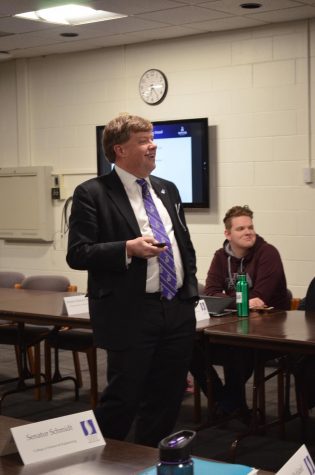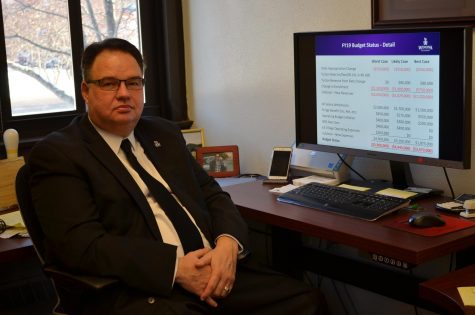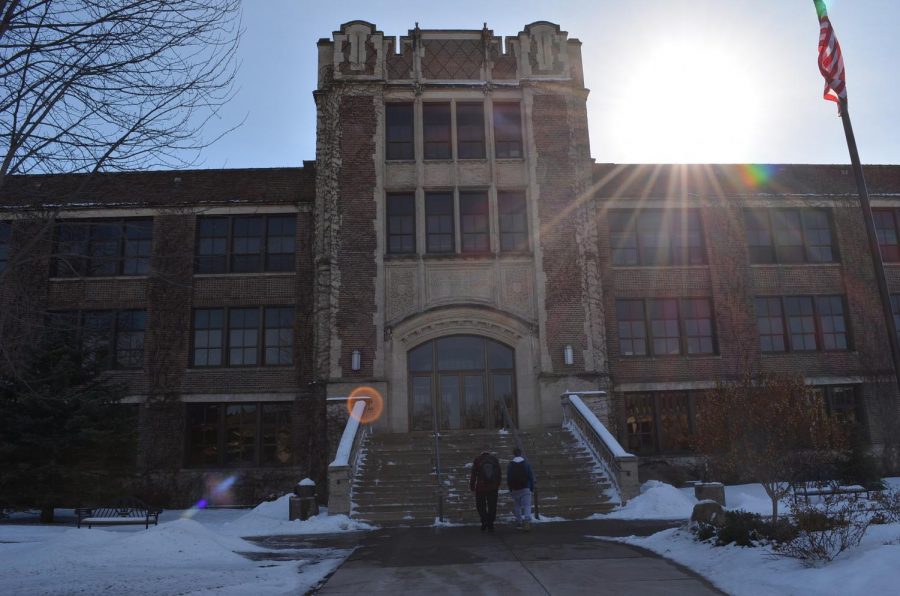Budget cuts torment liberal arts, student life fee
Campus budget reduced by $5.8 million, students unaware
With over $5 million in budget cuts for the fiscal year 19, some departments will be hit hard and others will come away with little budget reduction. The college of liberal arts, one of the biggest colleges at the university, has the largest budget reduction of $858,600 for the next fiscal year.
February 28, 2018
Winona State University is cutting over $5 million out of the overall budget for fiscal year 19.
Each division was instructed to reduce their overall budgets by seven percent but they did not have to do that equally between all the departments within the division.
Each vice president has a division that they are in charge of, then each division is broken up into departments.
For example, Scott Ellinghuysen is in charge of the division finance and administration but within that there is the facilities, human resources and other departments.
“Not every department will be [cut] seven percent, it is not an across the board cut,” Ellinghuysen said. “Some departments are more some departments are less.”
This is attributed to eliminating open positions across campus. In total the university eliminated 44 positions without layoffs.
Those positions were not distributed equally throughout departments, making it an unequal budget reduction across the departmental level.
The college of liberal arts was hit the hardest in this sense. They eliminated seven positions which was the highest across the university.
They also had the largest reduction of the university because they also eliminated two positions that will be vacant due to retirements as well as reducing two separate budgets. The college of liberal arts had to make a reduction of $858,600.
On the other hand, the President’s office had the least amount of reductions at $67,749, and only had to reduce its operating budget.
It is important to note however that the college of liberal arts and the president’s office are not under the same division.
In total the university reduced its budget by $5,849,257 for fiscal year 19.
One of the cuts was to eliminate three base graduate assistants that work with academic affairs. This was a reduction of $38,320.
Though the university said they did their reductions with no layoffs and that they wanted students not to feel the budget deficit, these three student workers were laid off.
On top of that, students were not updated as much as faculty was during the process.

President Scott Olson speaks to Student Senate about Winona State University’s budget for the fiscal year 19. The university will cut over $5 million from the budget and plans on eliminating 44 positions with no layoffs.
Faculty members were sent emails regarding the goals, budget forums and other information.
One of the opinions, according to Ellinghuysen and Andrea Northam, director of communications and marketing, is that students would not care about reductions because tuition was not going up.
“Part of the thing I think that is different when we do this is the history that students are very sensitive to the whole tuition issue,” Ellinghuysen said.
The idea is that because of the tuition freeze the students would not be interested in hearing how the budget changes may or may not affect their educations.
Northam agrees with Ellinghuysen.
“Being that tuition is not on the table, it is often a ticking point for students, that they want to be informed and know what tuition is and what direct impact will be felt by our student body,” Northam said.
There is debate on who is responsible to tell the students about these issues if they were to be informed more.
Ellinghuysen said that it is the responsibility of the communications department. However, he says the way that the all campus emails are sent out can be confusing as well.
Whereas Northam, Joe Reed, student activities director, and Patricia Rogers, vice president of academic affairs, said that those that are a part of student government, whether that be through the Student Fund Management Committee (SFMC), Student Senate or other student committee positions, are supposed to inform the student body on the budget reductions.
Students are able to attend all SFMC meetings and read the meeting minutes online.
“SFMC meetings aren’t restricted from the public, and we don’t have rules against people sitting in on the meetings,” Student Senate treasurer Christina Melecio said. “However it does not have a gallery.”
Melecio later stated that she too agrees that students typically are not drawn to this issue.
“I think that yes, students should be aware of their fees,” Melecio said. “I would love to discuss this with students, but usually there isn’t a huge draw to this particular topic.”
There is also blame being placed on what is cause of the budget deficit.
Ellinghuysen stated that enrollment plays a large role in the money available to the budget.
“With the declining enrollment it is kind of hard,” Ellinghuysen said.
However, McDowell says that there are five contributing factors to the budget deficit, two in which are related to enrollment.
Those factors are enrollment, retention, state appropriation, tuition freeze and salary settlements.
McDowell says that all her division can do is focus on fixing the factors that they can control, which includes retention and enrollment.
“What we can do and what enrollment and student life is focused on is how do we take care of the lanes for which we can control,” McDowell said.
McDowell’s goal is to reach a first-year class of 1,700 students by the year 2020 and keep that number steady for years to come. Including first-year students, transfer students and graduate students there were 2,284 new students the fall of 2017.
McDowell’s division is working toward that goal by working on broadening their reach to new students, using a variety of technology to communicate with incoming students and how to stand out among other schools.
McDowell said that they will still focus on Minnesota and Wisconsin because that is where the bulk of students are from. However, they are going to try to reach out to other Midwest states like Illinois, Iowa and Ohio, which all have similar climates to Minnesota.
“One of the things we know is if we can just get a student onto campus they will fall in love with Winona,” McDowell said.
McDowell has also started to use texting along with email and other forms of correspondence with prospective students.
Media Cross has helped to spruce up some of the university’s advertisements and help make the university stand out at college fairs.
One budget that is more reliant on the enrollment rates is the student fee budget that is handled by the SFMC.

Scott Ellinghuysen is the Vice President of Finance and Administration and Chief Financial Officer (CFO) at Winona State University. Ellinghuysen is in charge of financial planning for the university and ran the budget forums during the 2017-18 school year.
This budget is about a million dollars a year that is made up solely by the student fee built into tuition. This is the budget that pays for clubs and organizations like UPAC, Student Senate, sports clubs and KQAL.
According to the all university budget, KQAL is under review.
Rogers said that it is because the radio station is not built into the curriculum in the college of liberal arts anymore, so they should not have to pay for it. However, according to the SFMC budget reports KQAL is paid for with student fees.
Rogers said that the university wants to look over some options for the campus radio station.
“We pulled KQ completely out of the college of liberal arts just out of budget considerations and now there is an analysis gong on looking at what are all the things involved in KQ,” Rogers said. “In the athletic world if we didn’t have KQ broadcasting of that who would do that because we still want Warrior athletics.”
Those who run the station are paid and the station takes in grants.
When asked if the university was going to get rid of KQAL, Rogers responded saying no.
“I don’t think so,” Rogers said. “I think it’s just kinda like what does it mean to have a radio station on the campus.”



































